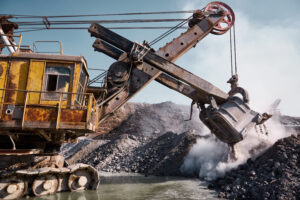Great Northern Minerals gets its kicks near Route 66
![]() Stuart Roberts, September 9, 2025
Stuart Roberts, September 9, 2025
When Great Northern Minerals (ASX:GNM) announced on 22 August 2025 that it had made a ‘strategic acquisition of a REE-antimony project in the world class Mountain Pass District of California’, we were a little disbelieving. Surely, we thought, all the exploration ground around Mountain Pass was already taken, and yet here was GNM: a junior explorer on the ASX that had been able to secure ‘lode claims’ in the neighbourhood.
What are the Best ASX Resources Stocks to invest in right now?
Check our ASX stock buy/sell tips
What happens near Vegas
The Mountain Pass we’re talking about is the Mountain Pass Rare Earths Mine in California’s San Bernardino County, in the eastern Mojave Desert near California’s border with Nevada. If you’re driving west along the famous Route 66 from Chicago to Los Angeles, when you pass through Barstow, the San Bernardino County seat, you’re not far away from this very important mine. Even closer is Las Vegas, just 50 miles away on Interstate 15. In calendar 2024 Mountain Pass produced around 45,000 tonnes of rare earths oxides in concentrate, making it a noticeable percentage of the world’s total rare earths output.
What makes Mountain Pass important, however, is that it’s currently the only domestic source of rare earths in the United States. In a world where China still controls the vast majority of the world’s rare earths supply, and where rare earths are vital not just for the 21st Century economy but for national security – like, for a while there F45 fighter jets needed Chinese-sourced rare earths – Mountain Pass has become a strategically important mine. That makes exploration ground near the mine, such as that which Great Northern Minerals now controls, potentially very valuable.
What the heck is neodymium?
Time was when no-one really cared about rare earths, which are the 15 lanthanide elements (atomic numbers 57-71), along with scandium (atomic number 21) and yttrium (atomic number 39). Then around 15 years ago things started to change. Elements they never taught us in high school chemistry like praseodymium (atomic number 59), neodymium (60), terbium (65) and dysprosium (66) started to show up in things like high-performance permanent magnets for electric vehicle motors and wind turbine generators. The applications became legion. Lasers needed neodymium. Medical imaging equipment needed terbium. Nuclear reactors needed dysprosium. Valuable defence material needed almost all the rare earths. And so on.
Meanwhile, China, with its large endowment of economic deposits, was focused on becoming the Saudi Arabia of rare earths and by the 2010s it was responsible for something like 70-80% of the world’s output. Which meant that by the time Donald Trump was US President for the first time, rare earths had become a big topic of conversation in Western public policy circles, where the focus was on how to reduce reliance on Chinese-sourced rare earths.
The place everyone in rare earths is talking about
When those conversations take place, Mountain Pass’s name usually comes up. That’s because the mine’s current owner, the Las Vegas-based MP Materials (NYSE: MP), is partly owned by Shenghe Resources (pronounced ‘sheng-hey’), That Shanghai-listed company, which sits within the orbit of Chinalco (that is, it’s partly state-owned and controlled) is the world’s second largest producer of rare earths, with both upstream and downstream assets.
Shenghe was part of the consortium which took Mountain Pass out of Chapter 11 in 2017 and was vital for its technical know-how. Its stake was diluted to around 8% when MP Materials went public in New York in late 2020, but until 2023 all Mountain Pass’s output was taken to China by Shenghe for processing. MP Materials now produces some refined rare earth oxides on site.
Mountain Pass’s continuing reliance on Shenghe was likely a reason that the Trump administration announced, in July, an arrangement whereby MP Materials would be guaranteed at least $110 per kg for its neodymium and praseodymium output, and that the government would take a US$400m stake in the company which would fund more downstream processing capacity in the US. MP Materials stock leaped in the news, and it is now capitalised at more than US$11bn, which is not bad given that the MP Materials consortium paid only US$20.5m in 2017. One investor who made out well from the news was Gina Rinehart’s Hancock Prospecting, which became a major MP shareholder in 2024.
Is there another mine to be found here?
Which brings us back to Great Northern Minerals with its newly pegged Catalyst Ridge Project at Mountain Pass. The 119 lode claims announced in August – a ‘lode’ claim is one that runs along a lode to the tune of 1,500 feet in length and 600 feet in width – sit only a few kilometres from the claims that cover the Mountain Pass mine. As do applications for an additional 96 lode claims announced on 9 September. The excitement around the future of Mountain Pass is likely to be good for Great Northern stock.
Since 2017, MP Materials has only focused on realising the value of the existing mine rather than focus on regional exploration. However, given the strategic nature of the Mountain Pass assets, it’s reasonable to expect that to change because there’s probably more rare earths deposits to be found in the neighbourhood. Mountain Pass sits in a carbonatite associated with other alkaline intrusives hosted in altered gneissic rocks, but around it, there are other carbonatites that haven’t really been looked at historically.
Living next door to Gina…and others
The terrane where one could find economic rare earth deposits at Mountain Pass is a northwest-trending belt of Proterozoic stocks and dikes that is 2.5 km wide and runs for about 10 km north and south of the mine. That’s plenty of room not just for Great Northern Minerals but also for Locksley Resources (ASX:LKY), and Bayan Mining and Minerals (ASX: BMM), which have also arrived in the district recently. Indeed, two of Great Northern’s blocks of lode claims sits either side of Bayan’s claims while is adjacent to Locksley’s claims. Another ASX-listed neighbour is Dateline Resources (ASX:DTR) with its Colosseum Gold and Antimony Project.
It’s still early days for Catalyst Ridge, with GNM now looking at the gravity and magnetic data to better understand the structures that it is sitting on. Next will come soil and rock chip sampling to guide the field work, after which the company can mobilise some drill rigs and see what its sitting on. It’s not just rare earths that it is looking for – the magnetite-breccia deposit that Dateline is working on at Colosseum seem to be geologically associated with the local carbonatites.
Great Northern Minerals’ share price jumped on the news of the Catalyst Ridge acquisition. It might lag for a while until the drilling starts, but the good news is that the current investor interest in rare earths isn’t going away. This is one investors should keep an eye on.
Disclosure: Great Northern Minerals is a research client of Pitt Street Research.
Blog Categories
Get Our Top 5 ASX Stocks for FY26
Recent Posts
FortifAI (ASX:FAI) Acquires NOL8 in a Bold Play to Power the Data Future
FortifAI’s NOL8 Acquisition Signals Next-Level Ambitions in Data Processing FortifAI Limited (ASX:FAI) surged 25% today after announcing a strategic pivot…
Fortescue (ASX:FMG) Digs Deeper Into Copper with Alta Acquisition
Fortescue’s C$139M Alta Deal Explained Fortescue (ASX:FMG) is moving to acquire the remaining 64 percent of Alta Copper Corp, a…
Electric Optic Systems (ASX:EOS) Lands Major $120M Asia Military Contract, Is It Time to Buy?
EOS Fires Up Second High-Energy Laser Sale Electric Optic Systems (ASX:EOS) is moving toward a potential partnership with a South…



